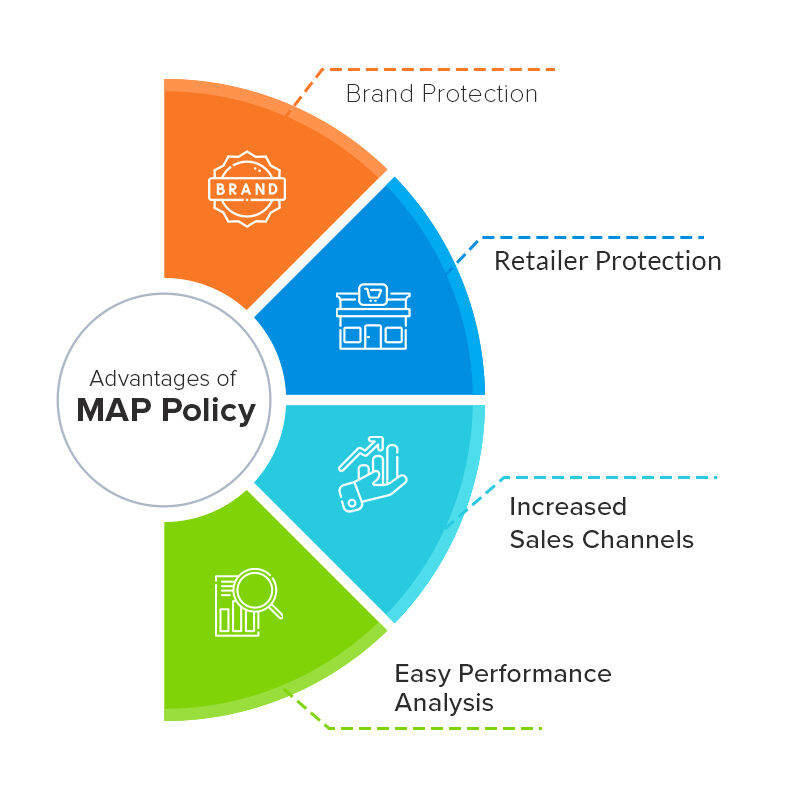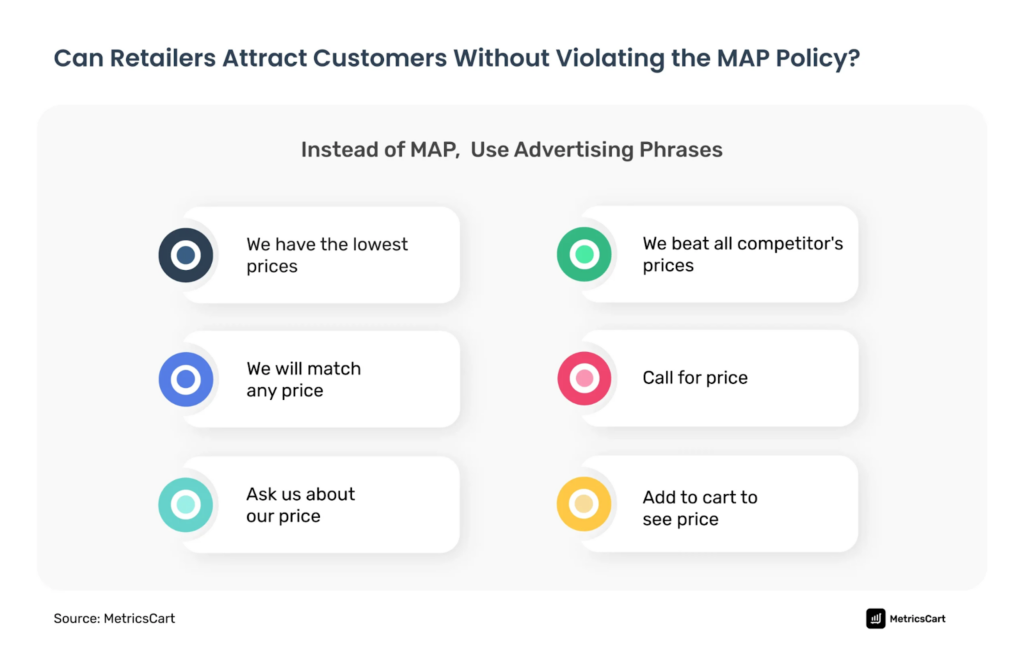In 2025, effective monitoring and management of Minimum Advertised Price (MAP) policy violations will continue to be a significant concern for manufacturers and brands. With the rise of e-commerce and online marketplaces, ensuring that resellers adhere to MAP pricing has become more challenging yet increasingly important. Let’s look at the current landscape of MAP policy enforcement strategies for effective monitoring and management of MAP pricing violations.
Understanding MAP Pricing Violation in 2025
MAP policies are agreements between manufacturers and their resellers that set the lowest price at which a product can be advertised.
They are crucial for maintaining brand value, ensuring fair competition among retailers, and protecting margins for both manufacturers and retailers.
MAP policies do not dictate the final sale price but limit the minimum price at which a product can be advertised.

Image Source: Metrics Cart
This helps prevent undercutting, which can erode the perceived value of the product and create a race to the bottom among resellers.
In 2025, these policies will become even more essential due to the growing dominance of e-commerce platforms, where pricing can fluctuate rapidly.
In the absence of robust MAP enforcement, brands risk losing control over their pricing structures, which can diminish consumer trust and brand equity.
The Challenge of Monitoring MAP Pricing Violations
With the vastness of the internet, monitoring for MAP pricing violations manually is impractical. The dynamic nature of online pricing, where prices can change multiple times a day, adds to the complexity.
Violations are not just limited to pricing; they can also include unauthorized promotions or bundled deals. The sheer volume of products and resellers makes it difficult for manufacturers to keep tabs on every violation.
In addition, unauthorized resellers often use different techniques to mask MAP violations, such as advertising the product at a lower price only after a customer adds it to their cart.
This further complicates the task of detecting violations, as traditional methods of price tracking may miss these instances.
Moreover, promotions and sales events can blur the lines between compliance and violation, leading to more disputes between brands and their resellers.
Technological Advancements in MAP Monitoring
In 2025, advanced software solutions will have become essential in monitoring MAP pricing violations.
These technologies use sophisticated algorithms and artificial intelligence to scan thousands of retailer websites, online marketplaces, and even social media platforms to detect violations.
They provide real-time alerts and comprehensive reports, making it easier for brands to enforce their MAP policies.
These tools can identify patterns of MAP pricing violations, which helps brands focus their efforts on resellers who frequently violate the agreement.
Some of the most effective MAP monitoring systems are integrated with e-commerce platforms, allowing for seamless detection and enforcement.
The use of big data analytics allows brands to gather insights from millions of data points, ensuring they can stay on top of emerging trends in reseller behavior and pricing discrepancies.
Proactive Measures for MAP Policy Compliance
A proactive approach to MAP compliance is vital for reducing violations and maintaining healthy relationships with resellers.
The key is not just reactive enforcement but active collaboration and communication with retail partners.
Several proactive measures can be taken to ensure MAP policies are adhered to consistently:

Image Source: MetricsCart
- Clear Communication of MAP Policies: Brands should ensure that their MAP policies are clearly communicated and understood by all their resellers. This includes detailing the consequences of non-compliance. When policies are ambiguous or not well-publicized, resellers may inadvertently violate them.
- Regular Training and Education: Offering training sessions for resellers about the importance of MAP policies and compliance can foster a cooperative relationship. Training should focus not just on the rules but also on the long-term benefits of maintaining a stable price structure for the entire retail ecosystem.
- Building Strong Relationships with Retailers: A collaborative approach with retailers can lead to better compliance. Retailers who feel valued are more likely to respect MAP agreements. Providing support to resellers, such as promotional materials or strategic guidance, can help ensure they remain committed to following the policies.
- Incentivizing Compliance: Some brands are introducing incentives for retailers who consistently adhere to MAP policies, such as preferred supplier status or access to exclusive products. This approach turns MAP compliance into a mutually beneficial arrangement rather than a one-sided obligation.
Responding to MAP Pricing Violations
Even with the best efforts, MAP pricing violations are bound to occur. Having a well-defined, swift, and consistent response strategy is essential for protecting the brand’s integrity and market position.
When a violation is detected, taking immediate action helps prevent the spread of further infractions.

Image Source: Seller Interactive
- Immediate Notification: Upon detection of a violation, the reseller should be notified immediately. This communication should be clear, concise, and assertive. Automated systems can help generate violation alerts and notify resellers in real-time.
- Enforcement of Penalties: Consistent enforcement of penalties, as outlined in the MAP agreement, is essential. This might include temporary suspension of supply or termination of the agreement in severe cases. However, brands should strike a balance between enforcing penalties and maintaining positive reseller relationships.
- Legal Action: In cases where resellers repeatedly violate MAP policies, legal action may be necessary. It’s crucial to have legal counsel to navigate these situations. Brands should ensure that their MAP agreements are legally sound and enforceable to avoid complications during legal proceedings.
The Role of Data Analytics in MAP Pricing Violations
Data analytics plays a significant role in understanding MAP pricing violations. Analysis of violation patterns can help brands identify potential weak spots in their distribution channels or specific products that are more prone to violations.
This information can guide future strategies and policy adjustments.
By analyzing data, companies can pinpoint which resellers frequently violate MAP policies, allowing them to focus their efforts on addressing these areas.
Moreover, analytics can help brands adjust their pricing policies to better align with market trends and consumer behavior, creating a more resilient strategy in the long term.
Collaboration with Online Marketplaces
Collaboration with major online marketplaces like Amazon, eBay, and others is crucial.

Image Source: Mayple
These platforms have taken steps to assist brands in enforcing MAP policies, including providing tools and resources to report and manage violations.
However, not all online marketplaces are equally supportive. Some platforms allow unauthorized resellers to operate with little oversight, making it difficult for brands to maintain control over their pricing.
In such cases, brands may need to work with third-party monitoring services to detect violations and work through official channels to resolve them.
Platforms like Amazon have MAP compliance tools that automatically remove listings violating MAP policies, but brands must proactively engage with these features to ensure maximum protection and ensure no MAP pricing violations occur.
Future of MAP Pricing Violations in 2025 and Beyond
As e-commerce continues to evolve, MAP enforcement will likely face new challenges.
Emerging technologies, such as blockchain, may offer solutions for tracking and verifying the authenticity of resellers and ensuring compliance with MAP agreements.
Blockchain could provide a transparent and immutable record of transactions, making it easier to trace violations and hold resellers accountable.
Additionally, with the rise of new selling channels such as social media and direct-to-consumer (D2C) models, brands will need to expand their MAP enforcement strategies to cover these areas.
Social media platforms, in particular, pose a challenge as they provide informal selling opportunities that may not be subject to the same scrutiny as traditional e-commerce sites.
Conclusion on MAP Pricing Violations
Effective monitoring and management of MAP pricing violations in 2025 require a combination of advanced technology, clear communication, consistent enforcement, and strategic collaboration.
Brands must stay vigilant in adapting their MAP enforcement strategies to the ever-changing landscape of e-commerce and online retail.
By leveraging technology, fostering strong relationships with resellers, and taking a proactive approach to compliance, manufacturers can ensure that their MAP policies remain effective in preserving brand value and ensuring fair competition.
42Signals helps e-commerce brands identify and tackle MAP pricing violations to ensure that their brand reputation isn’t diluted. To know more, visit our pricing page for our services.
FAQs
What is a Violation of MAP Pricing?
A violation of MAP pricing occurs when a retailer advertises or sells a product below the price specified by the manufacturer in its Minimum Advertised Price policy. This does not necessarily refer to the actual selling price, but rather to the price at which the product is advertised, which can include listings on websites, catalogs, or in-store displays.
What are the Penalties for MAP Pricing Violations?
Penalties for violating MAP policies can vary. Manufacturers may impose sanctions such as suspending orders to the violating retailer, removing the retailer from authorized dealer lists, or limiting their access to future product releases. In some cases, legal action or monetary fines can also be imposed, especially if the violation breaches a contractual agreement.
How Do You Enforce MAP Policies?
Enforcing MAP policies typically involves a few key steps:
- Clear Communication: Ensure that all retailers are aware of the MAP policy and understand its terms.
- Monitoring: Regularly monitor retailer prices across various platforms, including online and brick-and-mortar stores.
- Enforcement Actions: If a violation is detected, the manufacturer should take appropriate action, which may include issuing a warning, removing the retailer from authorized lists, or legal action, depending on the severity and nature of the violation.
- Regular Policy Review: Continuously review and update the MAP policy to ensure it aligns with current market conditions and legal requirements.





